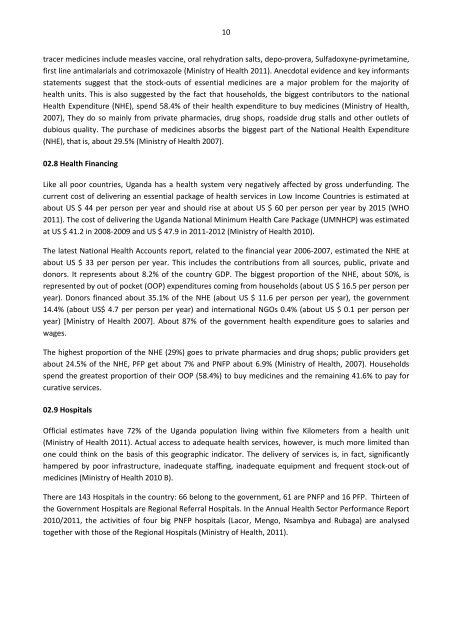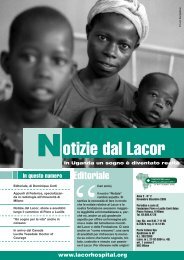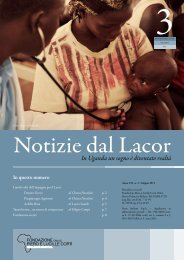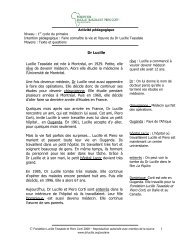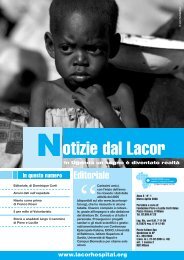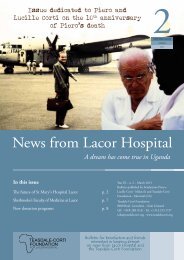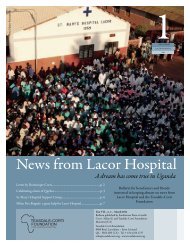Importance of LH on the local economy - Lacor Hospital > Home
Importance of LH on the local economy - Lacor Hospital > Home
Importance of LH on the local economy - Lacor Hospital > Home
You also want an ePaper? Increase the reach of your titles
YUMPU automatically turns print PDFs into web optimized ePapers that Google loves.
10tracer medicines include measles vaccine, oral rehydrati<strong>on</strong> salts, depo-provera, Sulfadoxyne-pyrimetamine,first line antimalarials and cotrimoxazole (Ministry <str<strong>on</strong>g>of</str<strong>on</strong>g> Health 2011). Anecdotal evidence and key informantsstatements suggest that <strong>the</strong> stock-outs <str<strong>on</strong>g>of</str<strong>on</strong>g> essential medicines are a major problem for <strong>the</strong> majority <str<strong>on</strong>g>of</str<strong>on</strong>g>health units. This is also suggested by <strong>the</strong> fact that households, <strong>the</strong> biggest c<strong>on</strong>tributors to <strong>the</strong> nati<strong>on</strong>alHealth Expenditure (NHE), spend 58.4% <str<strong>on</strong>g>of</str<strong>on</strong>g> <strong>the</strong>ir health expenditure to buy medicines (Ministry <str<strong>on</strong>g>of</str<strong>on</strong>g> Health,2007), They do so mainly from private pharmacies, drug shops, roadside drug stalls and o<strong>the</strong>r outlets <str<strong>on</strong>g>of</str<strong>on</strong>g>dubious quality. The purchase <str<strong>on</strong>g>of</str<strong>on</strong>g> medicines absorbs <strong>the</strong> biggest part <str<strong>on</strong>g>of</str<strong>on</strong>g> <strong>the</strong> Nati<strong>on</strong>al Health Expenditure(NHE), that is, about 29.5% (Ministry <str<strong>on</strong>g>of</str<strong>on</strong>g> Health 2007).02.8 Health FinancingLike all poor countries, Uganda has a health system very negatively affected by gross underfunding. Thecurrent cost <str<strong>on</strong>g>of</str<strong>on</strong>g> delivering an essential package <str<strong>on</strong>g>of</str<strong>on</strong>g> health services in Low Income Countries is estimated atabout US $ 44 per pers<strong>on</strong> per year and should rise at about US $ 60 per pers<strong>on</strong> per year by 2015 (WHO2011). The cost <str<strong>on</strong>g>of</str<strong>on</strong>g> delivering <strong>the</strong> Uganda Nati<strong>on</strong>al Minimum Health Care Package (UMNHCP) was estimatedat US $ 41.2 in 2008-2009 and US $ 47.9 in 2011-2012 (Ministry <str<strong>on</strong>g>of</str<strong>on</strong>g> Health 2010).The latest Nati<strong>on</strong>al Health Accounts report, related to <strong>the</strong> financial year 2006-2007, estimated <strong>the</strong> NHE atabout US $ 33 per pers<strong>on</strong> per year. This includes <strong>the</strong> c<strong>on</strong>tributi<strong>on</strong>s from all sources, public, private andd<strong>on</strong>ors. It represents about 8.2% <str<strong>on</strong>g>of</str<strong>on</strong>g> <strong>the</strong> country GDP. The biggest proporti<strong>on</strong> <str<strong>on</strong>g>of</str<strong>on</strong>g> <strong>the</strong> NHE, about 50%, isrepresented by out <str<strong>on</strong>g>of</str<strong>on</strong>g> pocket (OOP) expenditures coming from households (about US $ 16.5 per pers<strong>on</strong> peryear). D<strong>on</strong>ors financed about 35.1% <str<strong>on</strong>g>of</str<strong>on</strong>g> <strong>the</strong> NHE (about US $ 11.6 per pers<strong>on</strong> per year), <strong>the</strong> government14.4% (about US$ 4.7 per pers<strong>on</strong> per year) and internati<strong>on</strong>al NGOs 0.4% (about US $ 0.1 per pers<strong>on</strong> peryear) [Ministry <str<strong>on</strong>g>of</str<strong>on</strong>g> Health 2007]. About 87% <str<strong>on</strong>g>of</str<strong>on</strong>g> <strong>the</strong> government health expenditure goes to salaries andwages.The highest proporti<strong>on</strong> <str<strong>on</strong>g>of</str<strong>on</strong>g> <strong>the</strong> NHE (29%) goes to private pharmacies and drug shops; public providers getabout 24.5% <str<strong>on</strong>g>of</str<strong>on</strong>g> <strong>the</strong> NHE, PFP get about 7% and PNFP about 6.9% (Ministry <str<strong>on</strong>g>of</str<strong>on</strong>g> Health, 2007). Householdsspend <strong>the</strong> greatest proporti<strong>on</strong> <str<strong>on</strong>g>of</str<strong>on</strong>g> <strong>the</strong>ir OOP (58.4%) to buy medicines and <strong>the</strong> remaining 41.6% to pay forcurative services.02.9 <strong>Hospital</strong>sOfficial estimates have 72% <str<strong>on</strong>g>of</str<strong>on</strong>g> <strong>the</strong> Uganda populati<strong>on</strong> living within five Kilometers from a health unit(Ministry <str<strong>on</strong>g>of</str<strong>on</strong>g> Health 2011). Actual access to adequate health services, however, is much more limited than<strong>on</strong>e could think <strong>on</strong> <strong>the</strong> basis <str<strong>on</strong>g>of</str<strong>on</strong>g> this geographic indicator. The delivery <str<strong>on</strong>g>of</str<strong>on</strong>g> services is, in fact, significantlyhampered by poor infrastructure, inadequate staffing, inadequate equipment and frequent stock-out <str<strong>on</strong>g>of</str<strong>on</strong>g>medicines (Ministry <str<strong>on</strong>g>of</str<strong>on</strong>g> Health 2010 B).There are 143 <strong>Hospital</strong>s in <strong>the</strong> country: 66 bel<strong>on</strong>g to <strong>the</strong> government, 61 are PNFP and 16 PFP. Thirteen <str<strong>on</strong>g>of</str<strong>on</strong>g><strong>the</strong> Government <strong>Hospital</strong>s are Regi<strong>on</strong>al Referral <strong>Hospital</strong>s. In <strong>the</strong> Annual Health Sector Performance Report2010/2011, <strong>the</strong> activities <str<strong>on</strong>g>of</str<strong>on</strong>g> four big PNFP hospitals (<strong>Lacor</strong>, Mengo, Nsambya and Rubaga) are analysedtoge<strong>the</strong>r with those <str<strong>on</strong>g>of</str<strong>on</strong>g> <strong>the</strong> Regi<strong>on</strong>al <strong>Hospital</strong>s (Ministry <str<strong>on</strong>g>of</str<strong>on</strong>g> Health, 2011).


